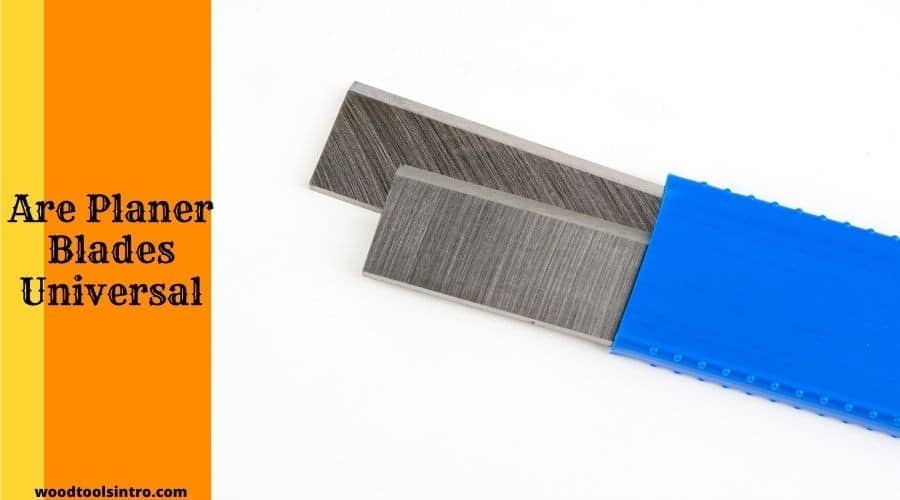Are you wondering whether the planer blades are universal or not? Since you are a woodworking artist, this is a question that needs some attention.

Planer blades are the cutting edges of the equipment that is mainly responsible for smoothening, chamfering, and easing the rough spikes of woodworking stock. The blades are always removable, they can be sharpened and replaced, and used in different projects.
So, to find out whether they are universal or not, let us read more about them below!
Are Handheld Planer Blades Universal?
Many handheld planer blades are universal, but there are some that are not. How can you know that your planer blades are universal? If your planer blades have only one edge, its cutting depth can be adjusted, and it can be re sharpened as well, then they are universal in nature.
Are Electric Hand and Thickness Planer Blades Universal?
The same can be said about electric and thickening planer blades. If they are reversible on both sides, their construction is made of solid carbide, and the blade life is long even after rebating and chamfering, then your blades are universal as well.
How Many Blades Are There On A Planer?
Typically, you will only see two blades on a planer, whether that be handheld, electric, or thickness planer. The blades make two cuts during each revolution while the machine is in operation.
However, do not be surprised if you find thickness planers with three blades. Thickness planers are heavy-duty machines, and the high number of blades provide extra smoothness and quality in the finished product.
On top of that, the three-blade planer is more economical than a 2-blade planer. That is because the three-blade planer does not need to be replaced and repaired as often as the 2-blade alternative.
Types Of Planer Blades
The length of planer blades can vary since there are too many types of planers out in the market. Other than a difference in length, you may also find that the blades are contrasting based on their shape, material construction, and thickness.
Thickness Planer Blades
When it comes to the thickness of the planer blades, thickness planers top any other type of planers that exist. Thickness planer blades also have longer cutting edges as opposed to the shorter ones of the hand planer blades.
Since thickness planers are designed for heavy-duty commercial work, their blades are surrounded by a metal housing. This provides them with the necessary stability needed during intense operations.
Automatic Hand Planer Blades
Hand planers, especially the manual ones, contain slim, flat blades for easy planning and shaving of wooden surfaces. The blades are the same with automatic hand planers.
Since the equipment must be held by a hand, the blades are lightweight, portable, and thin. They may or may not be housed with metal or wooden exterior.
Other Types of Planer Blades
There are planer blades with bevel edges which are called spiral planer blades. You can use these blades to produce distressed, uneven, and antique-like furniture and pieces.
On the other hand, shoulder, rabbet, and finger planer blades can produce beautiful rounded steps and edges. They are popular in creating minute wooden pieces, like toys and musical instruments.
For your information though, spiral, finger, rabbet, and shoulder planer blades need special types of planers to do the things mentioned above.
Can You Replace Blades On A Planer? How?
Planers are a must-have in the world of woodworking. The thickness planers are full of high horsepower and maximum cutter head speed. Even the handheld planers are quite useful for making all types of things that you can only imagine.
Although handheld planers are simpler and easier to operate than thickness planers, the latter is a bit complicated to operate. That being said, if you are not careful, things can go really wrong with them!
Loosen the Bolts of the Planer
All planers, handheld or thickness, have their blades secured inside a number of bolts. A typical handheld planer may have three bolts, whereas the thickness planers may contain more than that.
You can loosen the bolts either with a ratchet or a flat-head screwdriver. In some cases, use an impact driver to unscrew the bolts on the thickness planer. That will save you so much time, trust me!
Slide the Blades Out of the Slots
Once the bolts are out of the way, you can easily get your hands on the planer blades. Slide the blades out of their slots very carefully. Turn over to the other side to get the blades out from that particular side.
Clean the Blades and the Inside of the Planer
Usually, I encourage people to clean the inside of the planer when the screws are undone and the blades are out. Depending on the current condition of the blades, you can either sharpen them or replace them completely.
Fit the New Blades into the Slots
Align the notch on the new planer blades, and slowly slide them into the slots that were previously occupied by the old blades. When you feel that the blades are perfectly in place, loosely tighten the bolts back, but not completely, especially if you are using an impact wrench.
Test Drive the New Blades
Finally, end this replacement process with a mini test drive. Plugin the power and run the planer over a piece of wood. If you have installed new blades, the stock is bound to come out nice and smooth!
To Conclude This Discussion
Some planer blades are universal, and some are not. At the end of the day, it depends on a few factors like the length of the edge, shape, the material that it is made of, and the type of planer needed for your job.
Furthermore, people often replace their planer blades too soon and end up spending too much money on them. Do not be like those people! Do your research before replacing them.

I am Imtiaj Islam. I am a wood working enthusiast, having 6 years of experience in carpentry work. I have a BBA graduate degree from Chittagong College. I got vocational training on wood works from Korean Polytechnic out of the quest and zest he has for carpentry as well. I take several wood projects and keep testing different woodworking tools for comfortable and perfect work. I just love playing with woods and machines.
